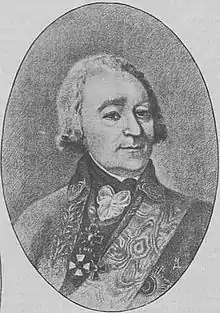Andrei Miloradovich
Andrei Stepanovich Miloradovich (Russian: Андре́й Степа́нович Милора́дович; 1727–2 May 1796) was a Russian military leader, statesman and lieutenant general. He is the father of general Mikhail Miloradovich.
Andrei Stepanovich Miloradovich | |
|---|---|
 | |
| Born | 1727 Pozniki, Cossack Hetmanate |
| Died | 2 May 1796 Chernigov, Imperial Russia |
| Allegiance | |
| Service/ | Army |
| Years of service | 1747–1796 |
| Rank | Lieutenant General |
| Wars | Seven Years' War Russo-Turkish War (1768–1774) |
| Awards | Order of St. George Order of St. Vladimir Order of Saint Anna Order of Saint Alexander Nevsky |
Biography
Born in 1727 in the village of Pozniki in the Chornukhy (that became a centesimal town Lubensky Regiment of the Hetmanate), he was descended from a Cossack sergeant of Serbian origin.[1][2] After graduating from the Kiev Theological Academy, he entered the military service in Little Russia, and in 1747 he received the title of ensign; in 1749, he was promoted to a lieutenant of a Life Guards company.[1]
The Seven Years' War with Prussia from 1756 until 1762 gave Miloradovich a chance to show his courage, and gain several ranks on the field of honor, particularly in the battles of Kay, Kunersdorf and the Siege of Kolberg. In 1771 during the Russo Turkish War Brigadier Miloradovich, fighting under the command of Pyotr Rumyantsev, distinguished himself in the very first campaign.[2]
Rumyantsev's 1800 infantry soldiers and 300 Cossacks crossed the Danube and defeated a Turkish force of 7,000 at Măcin in the Dobrudja region of Romania. Rumyantsev, in his report to Empress Catherine II, wrote the following about the battle:
"... Major General Miloradovich, first with light actions that served to draw attention to himself, gained surface over the enemy at the town of Măcin, and on the 21st, having crossed to the fertile shore with his corps, attacked the enemy in their encampment at Măcin, ousted them, captured the town and a significant number of guns."
For this conspicuous act, Miloradovich was awarded the Order of Saint Anna, 1st degree and Empress Catherine II even reported the fact in her letters to Voltaire with whom she often corresponded.[3][4]
Alexander Suvorov, Semyon Petrovich Ozerov (1725-1807) and Miloradovich stood out as heroes of the Battle of Kozludzha in 1773; the defeat of the Turks was complete.[5] As a reward for his brave actions in the war of 1771-1774, Miloradovich received the Order of St. George, 3rd degree (No. 44) on 10 July 1775. In addition, he was given the Voronki village in the Gorodishchensky centesimal Lubensky regiment.[6] In 1779, Miloradovich was promoted to lieutenant general and soon was appointed the governor of the newly-established Chernigov Governorate, which he ruled for more than fifteen years, but the governorship existed for a relatively short time and was replaced by the establishment of Little Russia. In 1786 he was awarded the Order of Saint Vladimir, 2nd degree and the Order of Saint Alexander Nevsky.
He died on 2 May 1796 in Chernigov, and was buried in the Yeletskyi Dormition Monastery.[7]
The Miloradović noble family is listed in the nobility of the Russian Empire.[8]
Awards and decorations
- Order of Saint Anna, 1st degree (1773)
- Order of St. George, 3rd degree (No.44; 10 July 1775)
- Order of Saint Vladimir, 2nd degree (1786)
- Order of Saint Alexander Nevsky (1786)
See also
- Peter Mikhailovich Kaptzevich
- Mikhail Miloradovich
- Ivan Shevich
- Avram Ratkov
- Ivan Adamovich
- Nikolay Bogdanov
- Nikolay Depreradovich
- Ivan Lukačević (soldier)
- Jovan Šević
- Jovan Albanez
- Simeon Piščević
- Anto Gvozdenović
- Semyon Zorich
- Peter Tekeli
- Georgi Emmanuel
- Dejan Subotić
- Fedor Yakovlevich Mirkovich
- Marko Ivelich
- Rajko Depreradović
References
- Translated and adapted from Russian Wikipedia.
- По ошибочным данным Руммеля и Голубцова А. С. Милорадович родился в 1729 г.
- Solovʹev, Sergeĭ Mikhaĭlovich (2003). The rule of Catherine the Great: War with Turkey, Polish partition, 1771-1772. ISBN 9780875692395.
- Walsh, Nick Paton (2006-06-02). "How Voltaire praised the 'enlightened despot' Catherine the Great". The Guardian.
- Reddaway, W. F. (2012-03-29). Documents of Catherine the Great: The Correspondence with Voltaire and the Instruction of 1767 in the English Text of 1768. ISBN 9781107694859.
- Dixon, Simon (2010-12-09). Catherine the Great. ISBN 978-1847651921.
- Kohut, Zenon E. (1975). "The Abolition of Ukrainian Autonomy (1763-1786): A Case Study in the Integration of a Non-Russian Area into the Empire".
- "Yeletskyi Dormition Monastery".
- Mandich, Donald R.; Placek, Joseph Anthony (1992). Russian Heraldry and Nobility. ISBN 9780963306395.